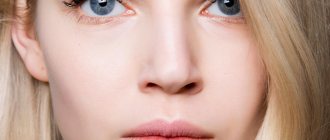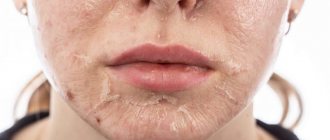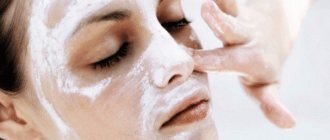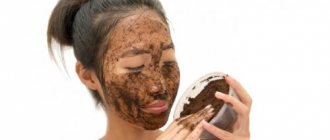The question of how to prepare face masks with fruit acids interests many representatives of the fair sex. Let's look at this issue in more detail. There are a large number of cosmetics on store shelves that help women maintain beauty and youth. Cosmetic companies, cosmetologists, and plastic surgeons work in this direction.
There comes a time in every woman’s life when she needs to decide on drastic changes. But you shouldn’t exclude from view care products made from natural ingredients. Their excellent anti-aging effect has been known for a very long time. You just need to choose those that suit your skin and do procedures with them regularly, in courses, then the desired effect will definitely come.
What is fruit peeling?
Fruit peeling is a cosmetic procedure used to cleanse the surface layers of the skin, activate restoration processes, eliminate acne, fine expression wrinkles, and hyperpigmentation. It is carried out with special fruit acids.
The method is popular mainly among young women, as it has been noted that in people over 45 years of age, the effectiveness of its use is noticeably reduced. TCA peeling, PRXT33 peeling, and salicylic peeling are more suitable for this age. This occurs as a result of the fact that exfoliating superficial peeling is able to cope with fine wrinkles and does not have the proper effect on deep ones.
Salicylic acid as a cosmetic product
A face mask with acetylsalicylic acid is a fairly popular product in modern cosmetology. The substance is used to combat inflammatory lesions of the dermis.
Since salicylic acid has antibacterial properties, it dries the skin and prevents irritation on the face.
The substance perfectly exfoliates old skin particles, eliminates blackheads, and copes with acne. Salicylic acid dissolves sebum and resumes processes in the structure of the dermis.
Which fruit acids have the properties necessary for peeling and regeneration?
- Lactic acid. There is often a misconception that this acid can only be found in milk and dairy products. However, its content is high in grapes, apples and even tomatoes. Due to the fact that lactic acid is a component of the natural moisturizing factor, it can be used by people with dry skin types. In addition, as a result of its gentle action on melanin, it has good whitening properties. Lactic acid is also used when performing milk peeling.
- Wine acid. High-quality wine and grapes contain this acid in combination with the active polyphenol resveratrol. This combination has powerful antioxidant properties, protects against ultraviolet rays, and has a rejuvenating effect on the skin of exposed parts of the body (face, hands).
- Glycolic acid. Sources of acid are sugar cane and grapes. The low molecular weight allows it to easily and freely penetrate into the deep layers of the skin and, by acting on melanin, lighten it. Glycolic acid is also used for glycolic peeling.
- Apple acid. This acid is found in apples and, not surprisingly, in tomatoes. It stimulates the activation of processes responsible for the regeneration and restoration of the skin after peeling.
- Lemon acid. All citrus fruits, especially lemons, are rich in this acid. It has a weak antiseptic effect, which helps protect the skin from the action of bacterial and viral agents. Natural antioxidant – rids the body of free radicals.
ANA, BHA, PHA - each skin type has its own acid.
Acids can be divided into two groups, which determine their use, depending on skin type. Skin type and age are the main criteria to consider when choosing cosmetics. For more details, read – Professional facial care cosmetics – recommendations for home use.
The division criterion is solubility in water or fat. AHA and PHA are water soluble. BHA, or rather the only (or almost the only) one used in cosmetics – salicylic acid – is fat-soluble.
This is not the only difference. In terms of the exfoliation mechanism, salicylic acid destroys the structure of proteins (corneodesmosomes, what holds the horny scales together), but AHA and PHA do not destroy the structure of proteins; for exfoliation, they change the activity of enzymes in the stratum corneum.
You can read more about ANAs and PHAs in the article – Cosmetics with acids.
Due to its lipid solubility, salicylic acid interacts with the physiological lipids of our skin. Therefore, it penetrates and acts inside the pores. It is mainly used to care for oily and problematic skin.
AHA and PHA acids are water-soluble and are used to care for dry and normal skin.
PHA is used in the care of sensitive skin.
Cosmetics with RHA.
Newskin Rich Cream, rejuvenating, anti-aging, Newskin Creme Riche Renophase - moisturizing, antioxidant cream, improves the lipid barrier.
Moisturizing cream Newskin Hydra+ Creme Hydra+ Renophase - renews the epidermis, reduces wrinkles.
Cosmetics with AHA.
Restoring serum with fruit acids Kosmoteros.
Milk-oil with fruit acids and Arcadia black wood mushroom extract.
Cream mask with fruit acids Ivory Arcadia.
This is interesting. We are used to the fact that the best care for oily skin can be provided by salicylic acid, but the Renophase cosmetics brand has reason to use glycolic acid in its care - Renewpure Emulsion Renophase.
Also, the mask has an interesting combination of components, where phytoestrogens are used together with glycolic acid, which improve the sensitivity of cell receptors to their own estrogens, which is important when hormonal levels change. Renewpeel Masque Renophase.
Cosmetics with salicylic acid.
Anti-acne tonic lotion with BHA Revolution studio, Peeling-gommage with BHA Revolution studio.
Let's summarize.
Oily, problem skin – salicylic acid.
Normal, dry skin – AHA.
Sensitive skin - RHA.
What are the features of multifruit peeling?
Despite the fact that fruit-acid peeling is a mild procedure, since, being superficial, it is gentle on the deeper layers of the dermis, it should be done in a salon. The percentage of active ingredients can be accurately determined by an experienced specialist. You should also select acids and their concentrations individually so that chemical multifruit peeling is safe and most effective.
What are the indications for using fruit peeling?
Fruit peeling is recommended in the following cases:
- The appearance of the first expression wrinkles. The active production of collagen and elastin by fibroblasts under the influence of fruit acids allows you to even out skin texture, eliminate stretch marks, and restore tone.
- Photoaging. Ultraviolet rays easily penetrate into the deep layers of the skin, dry it out and at the cellular level contribute to the appearance of free radicals, which leads to premature aging. In this case, even homemade fruit peeling has sufficient antioxidant protection to preserve youth.
- Acne rashes. The main factors leading to the appearance of this problem are: increased production of thick sebum and narrowed openings of the excretory ducts of the sebaceous glands. This procedure can regulate the functioning of the glands, expand pores, and counteract the development of inflammatory processes.
- Hyperpigmentation. The appearance of age spots occurs due to increased production of melanin and its uneven distribution in skin cells. Fruit acids reduce the synthesis of melanin granules by activating complex enzyme systems, and also distribute them evenly.
- Increased dryness of the skin. Lactic acid is one of the components of the natural moisturizing factor, which helps retain moisture in the surface layers of the dermis.
7 cases when there are contraindications to the use of fruit peeling
Fruit peeling is not recommended when:
- There may be hypersensitivity to the components of the peeling agent. In this case, you should consult a cosmetologist before starting the procedure.
- There is a tendency to allergic reactions. Perhaps you should choose a more gentle method of cleaning the skin.
- There are moles or neoplasms in the area affected by peeling agents. The procedure is quite aggressive and can serve as a reason that affects the growth of education.
- A woman is pregnant or breastfeeding. It is not worth carrying out chemical peeling at this time, since any effect on the mother’s body affects the baby.
- The skin in the affected area is injured, there are abrasions and wounds. Fruit acids can support the inflammatory process in the wound area and also cause the formation of deep scars.
- Recently got a fresh tan. For 2-3 weeks after tanning, you should refrain from visiting a cosmetologist, as the peeling procedure will be ineffective.
- There are deep wrinkles and scars, extensive age spots. Superficial fruit peeling is not able to cope with these skin problems. In this case, it is used only as an additional means, before more serious cosmetic procedures.
Fruit peeling for the face at home - popular recipes
For home peeling, you can use several popular recipes that replace the use of concentrated solutions of fruit acids in the salon.
Pineapple mask
You should take a pineapple, peel it, cut it into rings 1 cm wide. Pass two rings through a blender. Mix four tablespoons of pulp with 2 tablespoons of honey. Apply a thin layer to cleansed facial skin. Leave for 5-7 minutes. Rinse off with warm water. Apply restorative cream.
Citrus mask
Mix 2 tablespoons of freshly squeezed citrus juice (orange, lemon or grapefruit) with the same amount of olive oil. Apply to cleansed skin for 10 minutes. Rinse with water.
Grape mask
Mix grape juice with olive oil in equal proportions. Leave on skin for 10-12 minutes. The mask has whitening properties.
Strawberry mask
Wash fresh strawberries, mash them by hand or put them through a blender. Mix with 2 tablespoons of honey. Apply to the face, excluding the eye area. The approximate exposure time is up to 15 minutes. When using natural masks, the mandatory one-week breaks, as with chemical peeling, can be avoided, and the course may not be limited to 10 procedures. In addition, excess freshly squeezed juice can be used for food.
Preparing the skin and applying a mask with milk
In order for the facial skin to be most receptive to the effects of the beneficial substances of the milk mask, it must be properly prepared for the procedure:
- Remove makeup and any dirt from your face, wash with warm water.
- Do a light at-home exfoliation to help remove dead skin cells.
- Massage your facial skin by running your fingers along the massage lines several times. These lines go from the bridge of the nose to the forehead and up to the sides; from nose to cheeks and up; from the chin to the earlobes.
- Steam your facial skin by brewing any medicinal herb, for example, chamomile. There is also a second way to open the pores - make a compress of gauze (or a small terry towel) soaked in hot water or a decoction of medicinal plants.
- Whatever mask you prepare, you need to apply it for about 15-20 minutes. If you experience a feeling of tightness, this is normal; many components of masks with milk act in a similar way. If a burning sensation or itching occurs, it is better to wash off the mask without waiting for the end of the procedure. And no longer use a product with a similar component composition. It is advisable not to apply the nutrient mixture with your fingers, using cosmetic brushes, sponges or cotton wool.
- At the end of the procedure, the drug must be removed from the skin using a cotton pad or a piece of cotton wool, and then rinse the face first with warm, then with cold water.
Fruit facial peeling at home: real reviews
Making fruit peeling at home is very easy and simple. For this I used the following ingredients:
- natural apple cider vinegar - 1 tsp;
- honey - 1 tsp;
- crushed sea salt - 1 tsp.
Mixed all the ingredients and applied to a cleansed face. I left it on for 10 minutes and massaged my face a little at the last minute. I washed it off with warm water and applied a nourishing cream.
After 2 hours, the skin calmed down and the results were obvious: redness decreased significantly, the skin became very soft. This peeling works and is quite inexpensive.
Moisturizing hyaluronic acid mask
Regular procedures using masks with hyaluronic acid help prevent dehydration of the dermis, replenish the lack of moisture, and restore water balance.
Preparation, use:
- Peel a small cucumber and turn it into a smooth puree using a grater (blender). If it is too liquid, drain the liquid a little, otherwise it will be difficult to distribute the composition over your face.
- Add hyaluronic acid (10-12 drops) to cucumber puree. It is prohibited to exceed the recommended amount of the active component - abuse will lead to the opposite effect.
- Knead cosmetic clay with your hands, preferably yellow (15 g), and combine with the main mass.
- Cleanse the skin with a scrub.
- Carry out steaming - put a warm compress of linden decoction on your face (brew 100 ml of boiling water and 20 grams of dried flowers).
- After steaming, apply the cucumber mixture to your face, spread in an even layer, be sure to touch the area near the eyes (“crow’s feet”).
- Wash off no earlier than after half an hour.
Expert opinion
VERY HELPFUL!
Complete the manipulation by rinsing the dermis and applying a nourishing cream. It is recommended to use a plant-based product.











